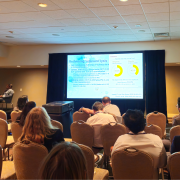ESJ Comment: Multimodal MRI in patients with unknown stroke onset: a sign of the times
Comment Authors: Sofia Grenho Rodrigues, Diana Aguiar de Sousa, Department of Neurology, Hospital de Santa Maria, University of Lisbon, Portugal
Mechanical trombectomy is of great therapeutic value in stroke patients with large vessel occlusions presenting within 6 hours from the stroke onset and there is growing evidence that this time-window can be even larger in highly selected patients. However, a significant proportion of patients with unknown stroke onset time may not qualify for these criteria. In order to identify patients who would still benefit from this treatment, being able to estimate the duration of stroke would be very useful.
In this paper published in the European Stroke Journal, the authors aimed to establish a model based on relative diffusion weighted (DWI) and perfusion weighted (PWI) imaging to provide accurate prediction of the 6 hours’ time-window for mechanical trombectomy, in patients with unknown stroke onset time and large vessel occlusion.
The authors performed a retrospective analysis of data from the DEFUSE 2 study and from a subgroup of patients included in the AXIS 2 trial. DEFUSE 2 was a prospective cohort of ischemic stroke patients with large vessel occlusions and NIHSS > 4 who underwent mechanical trombectomy and in whom an MRI within 12 hours from stroke onset was performed. The AXIS 2 trial included patients with anterior circulation ischemic stroke, presenting with NIHSS 6-22 and in whom an MRI within 9 hours from the stroke onset was performed. From the latter, the authors selected the subgroup of patients with large vessel occlusions. To be included, the images from DWI and PWI had to have good quality and show a core lesion with a persistent hypoperfused region. Images were processed using the software RAPID®.
181 patients were included – 91 from DEFUSE 2 and 90 from AXIS 2. The clinical characteristics were similar except for the core volume, which was larger in AXIS 2 (41 ml vs 26 ml) and time from stroke onset, which was also longer in AXIS 2 (330 min vs 270 min).
The images were analysed for multiple parameters. The time to the maximum of the residue function (Tmax) is an increasingly used measure of salvageable tissue in brain infarction. In this study, Tmax values higher than 6s were considered as critical hypoperfusion. Tissue at risk was calculated based on the difference between the hypoperfunded area (Tmax > 6s) and the ischemic core area (low apparent diffusion coefficient (ADC)). Relative diffusion weighted imaging (rDWI) signal intensity maps were also calculated comparing the signal intensity of the ischemic area to the homologue area in the contralateral hemisphere. The association between time from stroke onset and rDWI was studied in the non-reperfused core (Tmax>6s). Hypoperfusion intensity ratios were calculated by the ratio between Tmax>10s volume and Tmax>6s volume.
The predictive model was designed based on data from the de DEFUSE 2 study (derivation cohort) and validated in the subgroup of the AXIS 2 (validation cohort). When applying the predictive model to the validation group there was a drop on accuracy that can be partially explained from the differences between the two groups regarding inclusion criteria, presentation time after stroke, core volume, and methodology. In a second approach, the authors have merged both groups of patients and a second model was constructed with improvement of model sensitivity, positive predictive value and accuracy, and a mild drop in specificity.
This study shows that a multivariate automated imaging model including relative DWI (interquartile range and median), core volume, hypoperfusion intensity ratios and the interaction between median rDWI and hypoperfusion intensity ratios, can identify the likely timing of stroke (< 6 hours) amongst patients with large vessel occlusion and unknown duration of symptoms. The model has moderate accuracy and high positive predictive value.
Some limitation must be discussed, particularly the sample size of the derivation cohort and the use of MRI, which can raise accessibility issues. Also, the growing evidence that the time-window to mechanical trombectomy can be expanded limits the clinical use of this model. Still, methods to identify patients who are excluded when using the DAWN criteria are needed.
A number of patients with unknown stroke onset time and large vessel occlusion could benefit from mechanical thrombectomy. It is therefore of great interest to validate this automated multivariate imaging model to identify patients with onset within 6 hours in larger datasets.
The original article “Multimodal magnetic resonance imaging to identify stroke onset within 6 h in patients with large vessel occlusions” is available in the Online First section of the European Stroke Journal.
References:
Wouters A., Dupont P., et al. Multimodal magnetic resonance imaging to identify stroke onset within 6 h in patients with large vessel occlusions. European Stroke Journal 2018. doi: 10.1177/2396987317753486



